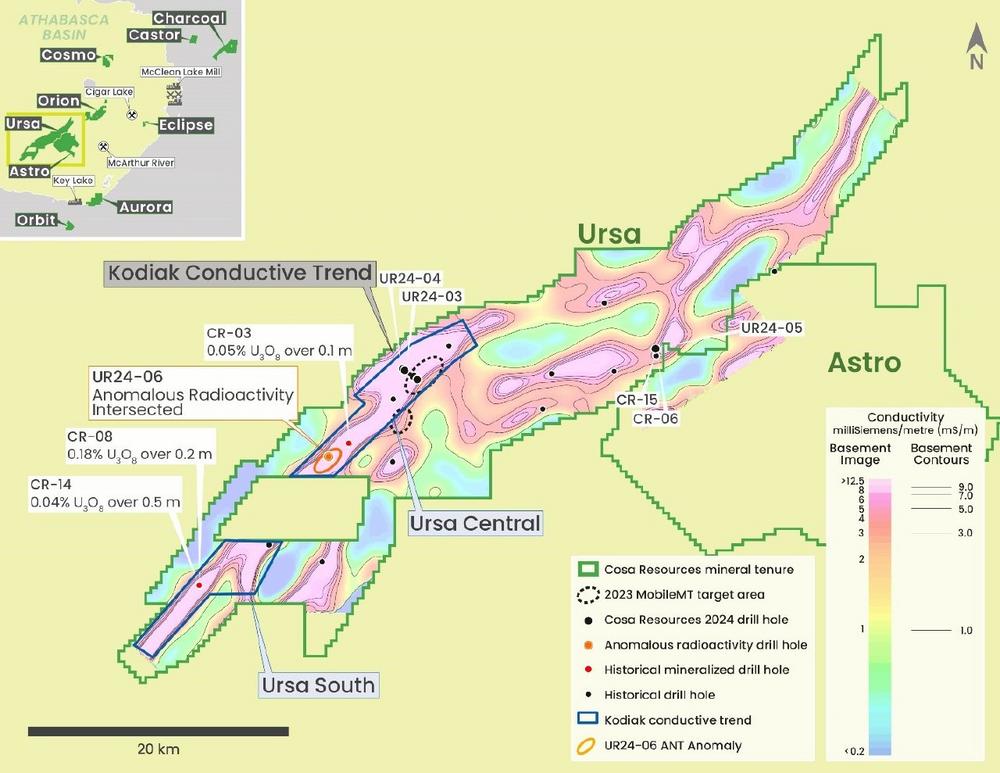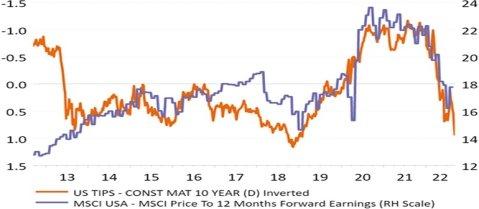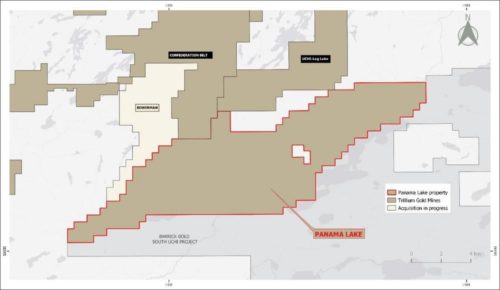
Cosa Resources Intersects Basement-Hosted Radioactivity at the 100% Owned Ursa Project, Athabasca Basin, Saskatchewan
Highlights
- Multiple zones of basement hosted radioactivity >1,000 counts per second (“cps”) (total counts, RS-125 hand-held spectrometer) and significant sandstone alteration intersected by drill hole UR24-06
- Drill hole UR24-04 intersected intensely graphitic basement intervals with fracturing down-dip of alteration and anomalous uranium geochemistry in the sandstone of drill hole UR24-03
- Confirmed effectiveness of Ambient Noise Tomography (“ANT”) as a strike prioritization tool
- Multiple additional target areas identified by initial results of the first of two ANT grids at Ursa
Keith Bodnarchuk, President and CEO, commented: “With only the second drill program on a Project that captures over 65 kilometres of underexplored conductive strike length we have significantly upgraded the Kodiak trend and the Ursa Project as a whole. Intersecting eastern Athabasca unconformity style sandstone alteration underlain by multiple zones of basement hosted radioactivity in drill hole UR24-06 is a significant achievement for our technical team and is a compelling demonstration of the prospectivity of the Cable Bay Shear Zone. The intensely graphitic basement conductor intersected by UR24-04, approximately 9 kilometres northeast of UR24-06 and on the Kodiak trend, suggests that significant structural disruption and hydrothermal alteration typical of the unconformity model may continue for many kilometres on the Project. Modern geophysical coverage has proven to be a worthwhile investment at Ursa, and we have never been more excited to return for follow-up drilling in the vicinity of these results and to continue evaluating additional kilometre-scale ANT anomalies.”
Andy Carmichael, Vice President Exploration, commented: “We are pleased that our first drill hole targeting the first anomaly from our first ANT grid area has intersected the strongest sandstone alteration on the Project to date and highly anomalous radioactivity in the basement. These positive results validate Cosa’s approach of using ANT to prioritize conductive strike length for testing with shallow-angle drill holes and emphasize the prospectivity of this highly underexplored project. With over 1.8 kilometres of untested strike length extending in both directions from this radioactive intercept, there is significant space for continued exploration, and we eagerly await uranium analytical results to guide follow-up. We are also encouraged that follow-up drilling to the north has confirmed that the sandstone-hosted alteration, structure, and anomalous geochemistry intersected in the winter are rooted in strongly graphitic basement rocks characteristic of currently producing mines in the Athabasca Basin.”
Diamond Drilling Results
Three drill holes totalling 3,423 metres were completed at Ursa to follow up winter drilling results and test an initial target area generated from the ANT survey completed by Cosa earlier this year.
The final hole of the program, UR24-06, targeted the Kodiak conductive trend where an overlying ANT anomaly was interpreted to reflect favourable structural disruption and/or hydrothermal alteration of the Athabasca sandstone. UR24-06 intersected a variably bleached zone from 814 to 923 metres which included intervals of desilicification, chlorite, hydrothermal hematite, structurally controlled sulphides, and up to 50% core loss (Figure 2), features consistent with eastern Athabasca unconformity style uranium deposits.
The unconformity was intersected at 1033.0 metres. Multiple intervals of anomalous radioactivity were intersected between 1087.8 and 1116.8 metres (Table 1). The strongest radioactivity (>1,000 cps) is between 1088.6 and 1089.0 metres with a peak of 2,700 cps and comprises black fracture fill and disseminations within graphitic and pyritic pelitic gneiss near its lower contact with an underlying pegmatoid unit which is weakly brecciated to 1098 metres. Hydrothermal hematite is associated with anomalous radioactivity, and pervasive chloritic alteration extends from above the radioactive pelitic gneiss to the base of the brecciation at 1098 metres. Radioactivity at 1095.8 metres is associated with an interval of increased hematitization of the brecciated and chloritized host rock and was flanked by 0.1 metre intervals of elevated radioactivity exceeding 300 cps. Zones of anomalous radioactivity intersected at 1116.8 and 1116.7 metres are associated with hematitic and limonitic coatings on concordant and discordant fractures. All measurements of radioactivity are total gamma from an RS-125 hand-held spectrometer. Spectral analysis with the RS-125 suggests the radioactivity is primarily due to uranium for all reported intervals.
The results from UR24-06 significantly upgrade the Kodiak trend and validate Cosa’s approach of using ANT surveying to prioritize conductive strike for drill testing.
Other Drilling Results
Nine kilometres north of UR24-06 along the Kodiak trend, drill hole UR24-04 followed-up a broad zone of pervasive sandstone alteration, structure, and anomalous geochemistry intersected by winter drill hole UR24-03. UR24-04 intersected weaker sandstone alteration and structure than UR24-03 and is interpreted to have undershot the optimal target by approximately 50 metres (Figure 3). Within the basement of UR24-04 and down dip of sandstone alteration in UR24-03, intervals of graphitic pelitic gneiss were intersected from 65 to 148 metres below the unconformity, which included decimetre- to metre-scale sections of sub-massive graphite with up to 15% sulphides. These results are the first on the Project to directly tie brittle structure and alteration in the sandstone to a graphitic basement root and confirm the prospectivity of the Project for high-grade unconformity-related uranium deposits of the Athabasca Basin.
Drill hole UR24-05 was completed to follow up sandstone alteration with highly anomalous geochemistry intersected by historical drill holes CR-06 and CR-15. As in the historical drilling, wide pervasively bleached intervals with short desilicified zones were intersected in the sandstone. Additional work will be influenced by pending geochemical results as the source of anomalous historical geochemistry remains unexplained in this area.
Next Steps
The Company believes that additional drilling to follow up the anomalous radioactivity in UR24-06 is warranted. Pending uranium analyses, Cosa considers both the down dip projection of the sandstone structure and alteration and the up-dip projection of the radioactivity to be strong follow-up targets. Additionally, ample exploration space exists along strike; the most proximal drill hole is weakly mineralized and located 1.8 km to the northeast, while 2.0 km of strike length remains open to the southwest (Figure 1).
Interpretation of results from the Ursa Central and recently received Ursa South ANT grids is ongoing and is expected to generate additional target areas for drill testing. ANT results for Orion remain pending. Cosa is considering additional ANT coverage in 2025 at Ursa and several of Cosa’s other Athabasca Basin projects.
All radioactivity measurements reported herein are total gamma from an RS-125 hand-held spectrometer. As the orientation of potential mineralization is unknown, the true thickness is also unknown. For additional information regarding the Company’s Ursa Project, please see the Technical Report dated October 5th, 2023 on the Company’s profile at www.sedarplus.ca
About Cosa Resources Corp.
Cosa Resources is a Canadian uranium exploration company operating in northern Saskatchewan. The portfolio comprises roughly 216,000 ha across multiple projects in the Athabasca Basin region, all of which are underexplored, and the majority reside within or adjacent to established uranium corridors.
Cosa’s award-winning management team has a long track record of success in Saskatchewan. In 2022, members of the Cosa team were awarded the AME Colin Spence Award for their previous involvement in discovering IsoEnergy’s Hurricane deposit. Prior to Hurricane, Cosa personnel led teams or had integral roles in the discovery of Denison Mines’ Gryphon deposit and 92 Energy’s Gemini Zone and held key roles in the founding of both NexGen and IsoEnergy.
Cosa’s primary focus through 2024 is initial drilling at our Ursa Project, which captures over 60-kilometres of strike length of the Cable Bay Shear Zone, a regional structural corridor with known mineralization and limited historical drilling. It potentially represents the last remaining eastern Athabasca corridor to not yet yield a major discovery. Modern geophysics completed by Cosa in 2023 identified multiple high-priority target areas characterized by conductive basement stratigraphy beneath or adjacent to broad zones of inferred sandstone alteration – a setting that is typical of most eastern Athabasca uranium deposits. During Cosa’s second and most recent drilling campaign at Ursa anomalous radioactivity was intersected in the basement below a zone of significant sandstone alteration and structure. Follow-up is planned in 2025.
Technical Disclosure
Drilling reported in this news release was completed with oriented NQ diameter drill core which was logged and sampled to capture geological information including alteration, structure, and mineralization. All drill core was systematically scanned for total gamma radioactivity using an RS-125 hand-held spectrometer and the average cps recorded for each 3-metre drill run. Intervals measuring over 1.5 times background levels were broken out and recorded. For intervals with elevated (>300 cps) radioactivity (RS-125), total gamma radioactivity was measured by removing sequential 0.1 metre lengths of drill core to an area with background radioactivity and scanned with an RS-125. For intervals measuring >500 cps (RS-125), spectral analyses were made using an RS-125 to characterize the relative contributions of uranium, thorium, and potassium to total gamma radioactivity.
Following completion of each drill hole, down-hole total gamma logging was completed using a Reflex EZ-Gamma system lowered inside the drill rods using the drill wireline. Measurements of total gamma were collected every 0.1 metres in both the down and up directions. Down-hole gamma logs were plotted alongside RS-125 total gamma measurements to confirm depths, handheld spectrometer readings, and assess total gamma radioactivity through intervals of unrecovered core.
Sampling was completed through zones measuring >300 cps using half-core samples between 0.1 and 0.5 metres in length. Samples were transported by Company personnel to SRC Geoanalytical Laboratories in Saskatoon, Saskatchewan (ISO/IEC 17025:2005 accredited) for U3O8 assay and multielement analysis. Certified reference material (“CRM”) blanks and standards were inserted into the split core sample series. Geochemical results are pending.
Historical drilling results in CR-06 and CR-15 are available within the Saskatchewan Mineral Assessment Database references 74G16-0008 and 74H13-0010. Relogging of these drill holes has not been completed as the cores have been destroyed by wildfire. Drill core photos from a portion of CR-15 have been obtained and reviewed by the Company to validate historical logging.
Qualified Person
The Company’s disclosure of technical or scientific information in this press release has been reviewed and approved by Andy Carmichael, P.Geo., Vice President, Exploration for Cosa. Mr. Carmichael is a Qualified Person as defined under the terms of National Instrument 43-101.
Contact
Keith Bodnarchuk, President and CEO
info@cosaresources.ca
+1 888-899-2672 (COSA)
In Europe:
Swiss Resource Capital AG
Jochen Staiger & Marc Ollinger
info@resource-capital.ch
www.resource-capital.ch
Cautionary Statements
Neither TSX Venture Exchange nor its Regulation Services Provider (as that term is defined in policies of the TSX Venture Exchange) accepts responsibility for the adequacy or accuracy of this release.
This press release contains forward-looking information within the meaning of Canadian securities laws (collectively “forward-looking statements”). Forward-looking statements are typically identified by words such as: believe, expect, anticipate, intend, estimate, plans, postulate and similar expressions, or are those, which, by their nature, refer to future events. All statements that are not statements of historical fact are forward-looking statements. Forward-looking statements in this press release include but are not limited to statements regarding, the Company’s exploration and development plans. Although the Company believes any forward-looking statements in this press release are reasonable, it can give no assurance that the expectations and assumptions in such statements will prove to be correct. Factors that could cause actual results to differ materially from such forward-looking information include, but are not limited to, changes in the state of equity and debt markets, fluctuations in commodity prices, delays in obtaining required regulatory or governmental approvals, and other risks involved in the mineral exploration and development industry, including those risks set out in the Company’s management’s discussion and analysis as filed under the Company’s profile at www.sedarplus.ca. Forward-looking information in this news release is based on the opinions and assumptions of management considered reasonable as of the date hereof, including the price of uranium and other commodities; costs of exploration and development; the estimated costs of development of exploration projects; the Company’s ability to operate in a safe and effective manner and its ability to obtain financing on reasonable terms. Although the Company believes that the assumptions and factors used in preparing the forward-looking information in this news release are reasonable, undue reliance should not be placed on such information. The Company disclaims any intention or obligation to update or revise any forward-looking information, other than as required by applicable securities laws.
Swiss Resource Capital AG
Poststrasse 1
CH9100 Herisau
Telefon: +41 (71) 354-8501
Telefax: +41 (71) 560-4271
http://www.resource-capital.ch
CEO
Telefon: +41 (71) 3548501
E-Mail: js@resource-capital.ch
Telefon: +41 (71) 354-8501
E-Mail: mo@resource-capital.ch
![]()





